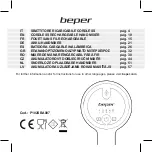
POWER CORE User Manual
Version: V6.0.0/5
80/459
9. Audio Mix Engine
Fader Down
Fader Toggle
Fader Up to Last
Value
Fader Toggle to Last
Value
Closes the source fader (see also
Hold Mode
below).
Changes the state of the source fader: open to closed, or vice versa (see also
Hold Mode
below)
.
Opens the source fader to its last known position.
Toggles the source fader to its last known state.
These 5 functions can be used to programme a fader start and are triggered by the rising edge
of the input control signal.
Hold Mode
When this input is active, the last position is stored when the fader is closed by
Fader
Down
/
Toggle
. Opening the fader using logic sets the fader to the last stored position. If
Hold
Mode
is activated while the fader is closed, then the
Default Position
set below is used.
Default Pos (dB)
Used in conjunction with
Hold Mode
. Sets the default level, in dB, to which the fader will open if
Hold Mode
is activated while the fader is closed.
DMS Color
The value entered here selects the colour for DMS meters within VisTool (see VisTool Editor:
PPM). The value shown is represented by 0xRRGGBB where RRGGBB denote the amounts of
Red, Green and Blue respectively. Click on the colour selector box to choose from the colour
palette.
Source Color
Selects the colour used to illuminate the fader strip backlight when the
Mode
is set to either:
·
Source Color Enabled
·
Mix Mode
If you select Black, then the backlight is unlit.
Source Color Mode
Select the mode of operation for the
fader strip backlight:
·
Source Color Enabled
- always indicates the type of source.
·
Source Color Disabled
- always indicates signal present.
·
Mix Mode
- combines the options above; signal present takes priority.
Signal present parameters are defined under "
System -> Definition -> Parameter = Signal
"..
Channel On Edge
Channel Off
Edge
Ch On/Off Toggle
Channel Mute
When a positive edge is supplied to this input, the source is unmuted.
When a positive edge is supplied to this input, the source is muted.
This input toggles the status of the channel mute on each rising edge of the control signal.
This input mutes the source as long as it is supplied with an active control signal.
These 4 control inputs allow the audio signal of a source to be switched on and off.
Access User Off
This input locks out the Access Key so that the source cannot be assigned to the centre
section. You may use this to limit operator access to source parameters.
Parm Page User Off
This input locks out all DSP modules for the source. You may use this to prevent parameters
such as a presenter’s mic EQ and Compression from being altered by the operator.
Channel Parm off
This input locks parameter control from the channel fader strip. You may use this to prevent
parameters such as mic gain and pan from being altered by the operator.
Ref Src
Selects the reference source. When a source is assigned to the control surface, a reference
source can be assigned at the same time. For example, on a console with two layers – on-air
and record – you could assign the TEL source to both layers automatically. In this parameter
box, assign the reference source (e.g. TEL).
To determine where the reference source appears on the control surface, use the
Ref Src
Fader Offset
option set within the “
System -> Definition -> Param = Fader
”.
Note that changing DSP parameters on one of the sources will affect the other.
Matrix Mic Nr
Matrix Gnet Port
These two fields are used if the audio input to the source is a microphone which requires
arbitration. See
Use the
Matrix Mic Nr
field to enter the
referenced within the server's
configuration.
In the
Matrix Gnet Port
field, enter the
port number which connects to the server.
















































